Interview with volunteer Ellen de Visser: “It’s like a gift from the past”

Ellen de Visser and three other #StolenMemory volunteers have spent the past one and a half years searching painstakingly for traces of victims of Nazi persecution in the Netherlands. Ellen has already managed to find the relatives of 39 former concentration camp prisoners whose belongings are stored in the Arolsen Archives. In the interview, she explains why she is so committed, tells us what helps her in her search, and talks about some of the experiences she has had along the way.
Ellen, why are you so committed to finding relatives of victims of Nazi persecution?
I have a very personal reason because my grandfather Jan was killed in Neuengamme concentration camp in December 1944. He was in the resistance , but someone betrayed him. He was sent to the Amersfoort transit camp before being deported to Neuengamme, where he died. And my grandmother never spoke of him again, nor did my other relatives. But after she died, we found the last letter my grandfather had written to her from Amersfoort just before he was deported to Neuengamme. She had always kept it in her little wedding book, but she hadn’t told us about it. It was a very moving letter. And when she was buried, during the ceremony in the church, the vicar also spoke about my grandfather. He said that the whole village had let my grandmother down. I found that fascinating. I thought, OK, what does he know that we don’t know? It turned out that she had spoken to him about what had happened.
Did your grandmother stay in the village?
Yes, she stayed in the village. Even though she knew that the man who had betrayed her husband also lived here. We never found out who he was. Before my grandfather had to leave his little village to go to Camp Amersfoort, he was able to give my grandmother his wedding ring. And she wore that wedding ring all her life, she really cherished it. It was the last thing he ever gave her. So that’s how I came to understand the value of these things to families. These objects were the last things people took with them on their final journey. So I was aware of the emotional value they had. That made me feel very strongly about the initiative, and I decided that I wanted to do everything I could to give these things back to the relatives of their owners. My grandfather’s wedding ring showed me the emotional value of the items featured in the #StolenMemory campaign.
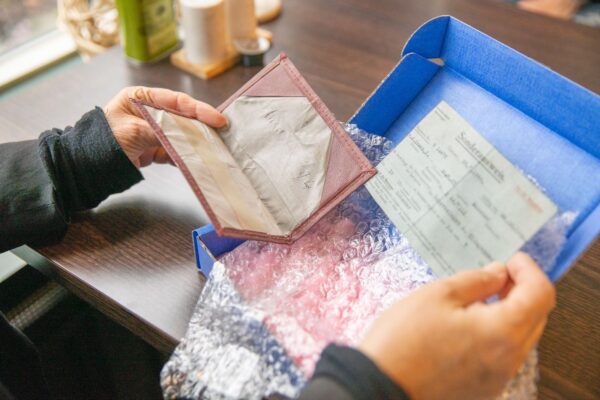
Belongings of Johannes van der Kraan, Photo: Harry Cook
How did you find out about the #StolenMemory campaign?
I started to reconstruct my grandfather’s life. I was very curious about what kind of man he was. What did he do in the Second World War? There is a monument to him in his small village. But why? What did he do? Who betrayed him? I was also curious to know why my grandmother kept quiet. Why didn’t she want to talk about him? I met one of the Dutch policemen who arrested him shortly before he died. He was very sorry for me and apologised. I think he was in his 90s. I also searched for information in various archives. I knew the Arolsen Archives from my work as a journalist. I write for the Volkskrant. And when you write about the war, you automatically come across the Arolsen Archives. I found some details and some documents about him there, and I decided to subscribe to the newsletter – that’s how I heard about the #StolenMemory project.
Did you decide to get involved right away?
At first I thought it was their project, I thought they did all the research themselves and that I couldn’t get involved. But then I read an interview with a Norwegian journalist, and she explained that she had found the relatives of all the Norwegian prisoners whose belongings were stored in the Arolsen Archives. She found them with the help of Norwegian television. That’s when I thought to myself, OK, I’m a journalist too, I could offer to help, and I did. I went to Bad Arolsen in November 2022, and they showed me the personal effects of all the Dutch prisoners. There were 30 of them I think, and there were also a lot of items whose owners had not been identified, but who were probably Dutch too.
What were your expectations? Did you think you would find so many families?
At the beginning I wasn’t expecting to be successful at all. I thought I might find one or two families. But when I asked the newspaper I work for if I could do the research as a newspaper project, even though I didn’t know what the result would be, they were really enthusiastic and said yes! So they gave me some money to set up a website so I could ask our readers for help, which is what the Norwegian journalist had done on TV. I put a short profile and a picture of each former concentration camp inmate on the website. We got a huge response. We have a lot of historians and former teachers among our readers, and they love hunting for information. Sometimes they send us the exact missing detail we need to fill a gap in our research.
But you do the initial research, right?
I knew immediately that I couldn’t do it alone. We are four volunteers: Erik Dijkstra, Theo van Bemmel, René Veldhuizen, and me. Two of them were already volunteers in Arolsen, and we make a great team. We help each other if one of us is stuck. I’m still amazed by our success, because so far we’ve found 39 families. Through the #StolenMemory project, I also found out that there are still items in Dutch archives waiting to be returned. The Red Cross did one last round of searches 20 years ago, but then they stopped because they ran out of money. Since then, the remaining belongings have been in the archives of the former transit camp in Amersfoort.
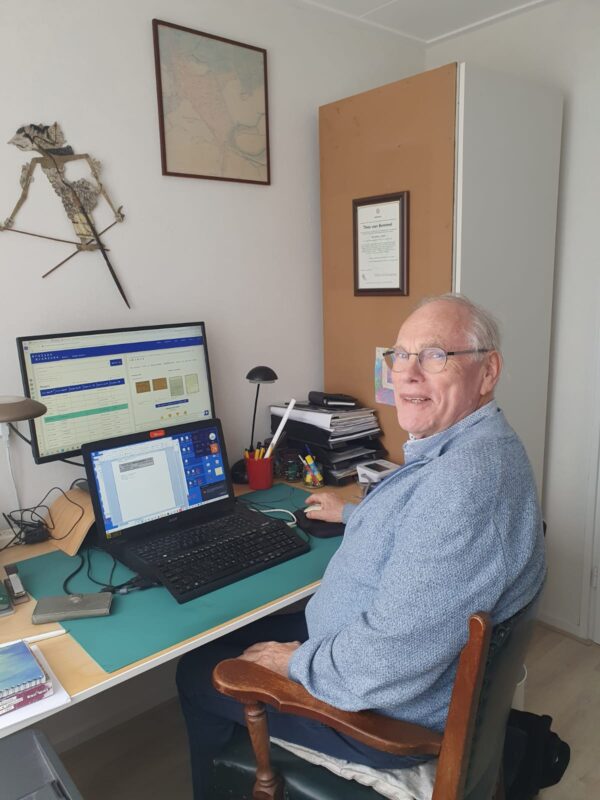
Volunteer Theo van Bemmel doing some research in the Arolsen Archives. Photo: Theo van Bemmel
How difficult is the research? How much time do you spend on the project?
A lot of my free-time, really. Although the newspaper gave me time, it took us weeks – even months – to find some of the families, though you can find others in just one evening. It all happened 80 years ago, and the prisoners themselves are no longer alive. A lot of them were very young and had no children. So you have to look for their nephews and nieces, and very often you even have to look for the children of their nephews and nieces. We draw up family trees and search in newspaper archives and old telephone books. We’ve written to regional archives and asked historical societies for help. We’ve also searched on social media. But now it’s getting harder and harder, and there are still families that haven’t been found. I think 15 in total. There are only a few items left in the archives in Bad Arolsen that belonged to Dutch people.
Is it worth all the hard work?
Yes, definitely! These things are like gifts from the past, you know. That’s how I see it: a gift from the past. When you see all the emotions when relatives get a wallet or a picture or a watch back. They’re so grateful for the work we’ve done. It’s so rewarding, I think for all four of us. Seeing how much our work means to people is what that keeps us going.
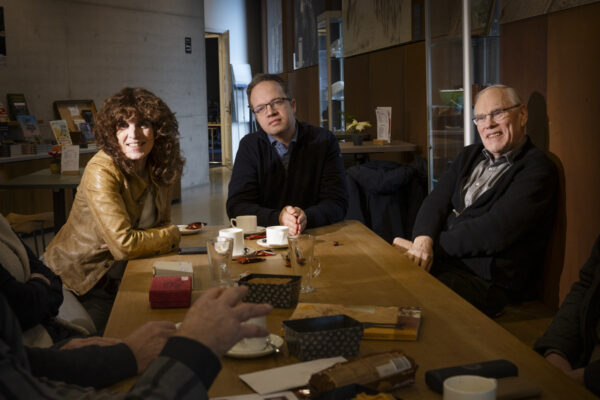
Dutch volunteers Ellen de Visser, Erik Dijkstra, and Theo von Bemmel return personal effects to a family at the Amersfoort memorial in September 2023. René Veldhuizen (not pictured) also helps them with their research. Photo: Pauline Niks
Are you always present when the belongings are returned?
Yes, if the relatives want the items to be handed over to them in person, I do it myself on behalf of the archive in Bad Arolsen, and their staff send the items to me beforehand. Almost all of the relatives have chosen this method so far, rather than having the items sent to them by post. Either I make an appointment in Amersfoort or we meet at their home.
The items that have been returned belonged to 39 people, so there are 39 stories to tell. Which family do you remember best?
There are so many touching stories… I found the story of a picture with four children on it very moving. We didn’t have the name of the owner, but we found out that it belonged to Klaas de Raad, a member of the resistance. We found his son, Freek, who’s now 89 years old. When we gave him the picture, he cried and said, “Look, look, the boy on the left in the picture, that’s me! The idea that his father had had his picture with him on the train from Amersfoort to Neuengamme… the thought that he must have looked at the picture of his four children on the journey was so emotional for him. He remembered his father very well, and he also remembered the day he was told that his father had died. And it all came back to him because of the picture.
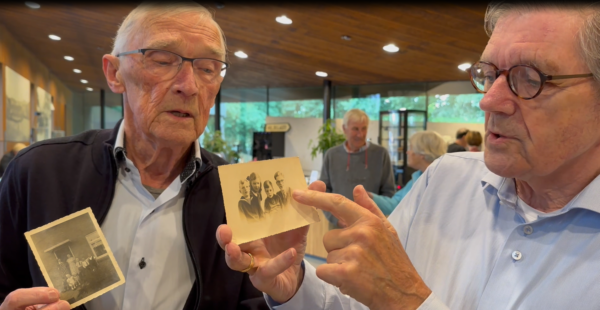
The sons of Dutch resistance fighter Klaas de Raad with belongings that were returned to them. They point to themselves on one of the photos. Volunteer René Veldhuizen stands in the background. Photo: Arolsen Archives
And there’s another beautiful story that’s also quite unusual. We had a wallet and a work permit belonging to a young man called Johannes van der Kraan. And when I started looking for him, I found out that he was buried in Loenen in a cemetery of honour. He had died after the war in a British hospital and had been reburied in the Netherlands. On the Wargrave Foundation website, I found a file containing correspondence with his father. But it seemed that his father hadn’t informed the rest of the family. No one knew about the grave. We found his niece, Maria, who suggested that he must have wanted to spare his wife and children the grief. She remembered that her grandfather often rode his bicycle to Loenen, but no one knew why. Now we know ¬ he was cycling there to visit his son’s grave. When we went to Loenen with his niece, she brought white roses to put on his grave, and she thought of her grandfather and of how he had always been alone when he stood at his son’s grave. This is the story that an old wallet and a work permit can tell.
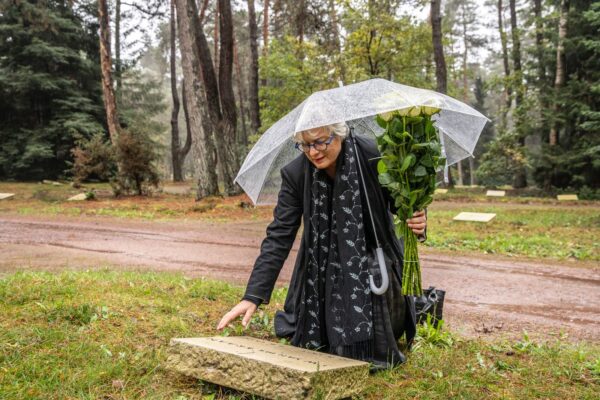
Maria van Loon, Johannes van der Kraan’s niece, at his grave in Loenen. Photo: Harry Cook
So you are not alone with your story of not talking about pain and loss after the war?
Yes, we found relatives who didn’t even know that their father or grandfather had been in a concentration camp. After the war nobody talked about it. For example, there was a daughter who felt she could have helped her father if only she had known about it. He had kept the whole story secret from his family because it was too painful for him. When we returned his watch to her, we brought the whole story back to her. The grandson of a man who was in the resistance told me in a phone call we had later: “The wallet is an ugly thing, but it was one of the last things he ever held in his hands so it has a place of honor in my living room.” For many people, these objects are of great value.

The personal effects of Maarten Vrolijk return to the Amersfoort memorial. His niece presents them to Floris van Dijk, who is Head of Research there. Maarten was a student resistance fighter. He died aged 22 in Sandbostel camp. There is no grave commemorating his death. For Maarten‘s family, the ceremony to mark the return of his effects felt like a belated funeral. In the background of the photo are volunteers Ellen de Visser and René Veldhuizen (center). Photo: Amersfoort memorial
Are all the relatives – Dutch young people in particular – interested in the past?
I think there is a growing interest in Nazi history and in the past. None of those prisoners talked about it themselves. But now their children and grandchildren, like me, want to find out what happened. When I visit archives, which I often do for the project, I find they are full of visitors. When I arrange dates to return objects to families, lots of grandchildren come and ask many, many questions.
Do you think you will eventually find all the families?
I think we will come very close for the objects stored in Arolsen. But it’s going to be difficult to find the families of the owners of all the effects in the Dutch archives in Amersfoort. There are two boxes full of envelopes with handwriting on them. Sometimes we can’t even decipher the letters. We have four wedding rings with inscriptions, but we don’t know who owned them, even though we’ve done everything we could to find out. I’m afraid some things will never be returned. But I think if we know we’ve done everything we can to find the relatives, it’s going to be all right in the end.

